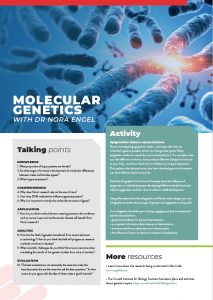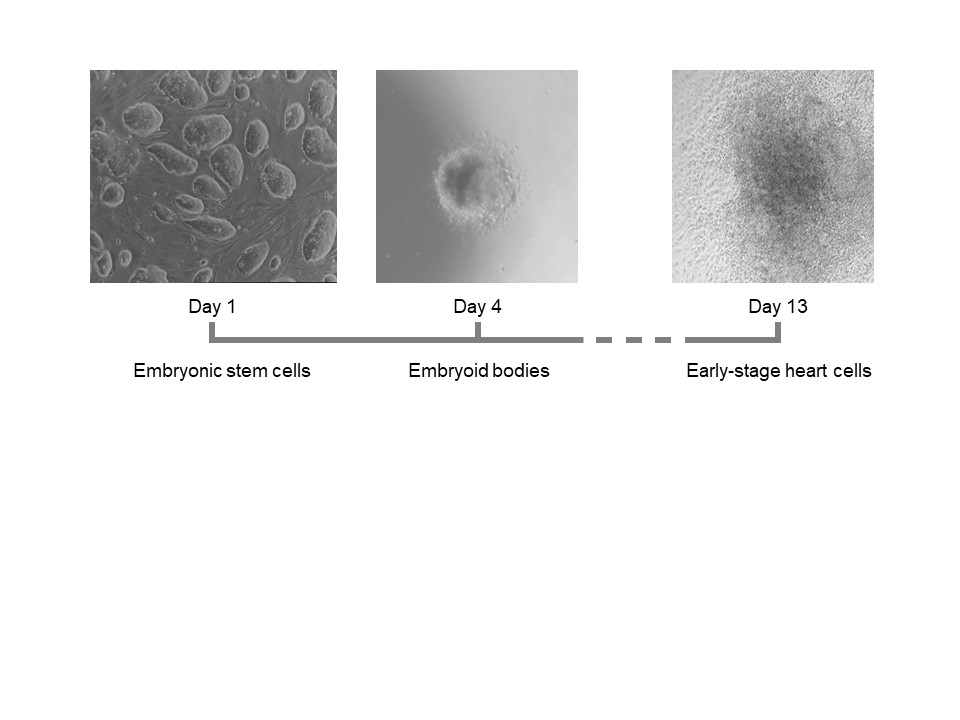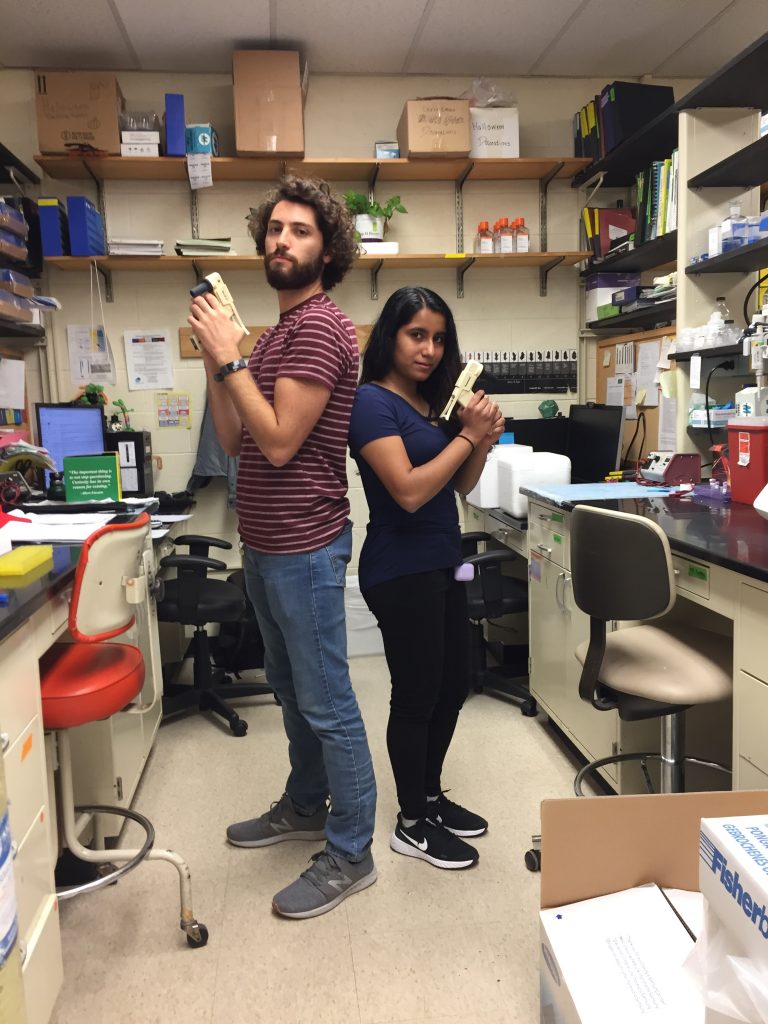Why do males and females have different risks of disease?
While males are more likely to develop cancer than females, most autoimmune diseases are more prevalent in females. For cardiovascular diseases, not only do males have a higher risk, but how the diseases present is also different than in females. Dr Nora Engel, a molecular geneticist at Temple University School of Medicine in the US, is examining sex differences in gene expression and DNA modifications to determine why this is the case.
TALK LIKE A…
MOLECULAR GENETICIST
Autoimmune disease — a disease in which the immune system attacks healthy cells
DNA — the molecule that stores genetic information in living cells
Epigenetic mark — a process that alters gene expression but does not change the DNA sequence
Gene — a section of DNA
Gene expression — the process by which an organism’s genetic information is used to produce end products, such as proteins, that influence the functioning and physical characteristics of the organism
Genomic — relating to the genome (the complete set of genetic material in an organism)
Hormone — a chemical messenger in an organism
Protein — a complex biological molecule, playing a variety of essential roles in living organisms
RNA — the molecule produced during gene expression that contains copies of a gene
Sexual dimorphism — when an animal species displays physical differences (not including the reproductive organs) between the sexes
Stem cells — non-specialised cells that, in an organism or in a lab, can grow into specialised cells
Transcription — the process of converting genes from DNA into RNA
Transcription factor — a protein that enables transcription
Have you ever wondered why male ducks are brightly coloured, while females are drab and brown? Although the aim of both sexes is to reproduce, the male’s role is to attract a mate, requiring it to be colourful and attractive, while the female’s role is to safely raise the young, requiring it to be camouflaged from predators. This is an example of sexual dimorphism, where there are physical differences between males and females of the same species, and it results from genetic differences between the sexes.
Lions are another example of a species that displays clear sexual dimorphism. A male lion’s genes cause it to grow a mane, while a female lion’s genes do not. Like all mammals, every cell in the human body has differences in gene expression between males and females. “Depending on the tissue, these differences can be subtle or substantial,” says Dr Nora Engel, a molecular geneticist at Temple University School of Medicine. “There are striking sex differences in gene expression in the brain, liver and muscles, but male and female gene expression is less divergent in the heart.” Nora is leading a team of researchers to uncover the genetic differences between males and females, and she hopes her research will help scientists understand how these differences impact sex-specific differences in health.
How do male and female genes impact risk of disease?
Males are at higher risk of certain diseases than females, while females are more likely to develop other conditions than males. For example, a male has a one in two chance of being diagnosed with cancer during their lifetime, while for females, the chance is one in three. However, lupus (an autoimmune disease) is more common in females; nine out of ten lupus patients are female.
“Unfortunately, we know very little about the impact that gene expression sex differences have on the risk of specific diseases,” says Nora. “A major goal of our lab is to bridge the gap between the molecular differences between males and females and the well-established sex biases in disease.”
What influences gene expression?
All living organisms have genes, which are responsible for the characteristics of that organism. DNA, the molecule that instructs cells how to function, is composed of these genes, and humans have over 20,000 genes inside every cell. The process of gene expression enables the genetic information stored in DNA to be converted into functional products, such as proteins, that influence the organism’s physical traits. Gene expression occurs by transcription, in which genes are copied from the DNA into molecules called RNA, by proteins known as transcription factors.
One process that regulates gene expression is DNA methylation, whereby a methyl group (one carbon atom and three hydrogen atoms) is added to a DNA molecule. “DNA methylation determines whether DNA is available for binding to transcription factors,” explains Nora. If the protein cannot bind to the DNA, then transcription of certain genes will be hindered.
DNA methylation is an example of an epigenetic mark, as it changes the DNA structure and the physical trait outcomes, but it does not alter the DNA gene sequence. Scientists have observed that DNA methylation varies widely between males and females, resulting in epigenetic differences between the sexes. “However, there is a huge gap between characterising sex differences in gene expression and epigenetic marks, and tying them to specific sex disparities in disease,” says Nora. As yet, scientists do not know how soon after fertilisation these molecular differences appear, or how they vary across a person’s lifespan. “Therefore, our goal is to characterise sex differences in gene expression, from the earliest stages of embryonic development all the way to adulthood,” says Nora. “Our hypothesis is that some of the sex differences we see in adult diseases will be explained at the molecular level, and that some of these molecular differences are established in the early stages of embryonic development and then persist into adulthood.”
What challenges must Nora overcome?
Nora’s experiments cannot be conducted in humans, so she uses animal models instead. “A key part of our research involves working with male and female mouse embryonic stem cells,” she says. By manipulating the genes of these mouse cells, Nora and her team of molecular geneticists have shown that male and female cells express RNA in different ways, and they are now testing how these differences affect epigenetic patterns. However, although embryonic development is similar in all mammals, some of the team’s findings may not be translatable from mice to humans.
Moreover, an obstacle to understanding sex differences is that there are two factors that contribute to them: the difference in sex hormones between males and females, and the genetic differences arising from the sex chromosomes, i.e., XX in females and XY in males. Disentangling these two components is a major challenge and requires using genetically engineered mice.
Another challenge is that Nora and her team conduct a lot of DNA and RNA sequencing, allowing them to establish which genes are expressed in male and female mouse cells. Despite being much smaller than humans, mice have a similar number of genes to us, meaning that each DNA sequence contains a huge amount of data. “This genomic data must be analysed by a bioinformatician, but there are very few of these highly specialised scientists,” explains Nora. “This means we have a long wait each time we need to get data analysed.”
What has Nora discovered?
Nora has initially focused on studying the differences in the hearts of male and female mice. “We have found sex differences in gene expression and epigenetics across all stages of life,” she says of this work. While some of these differences begin early in embryonic development and persist into adulthood, other differences disappear later in life. Some of the molecular differences between males and females do not occur until the mouse has grown and sex hormones start to circulate.
Reference
https://doi.org/10.33424/FUTURUM335
The team is now analysing the data to determine what sex-specific networks are driving the differences between male and female cells and how they relate to heart physiology and vulnerabilities. “We are also about to start a new project investigating sex differences in cancer,” says Nora.
After establishing the genetic and epigenetic differences between male and female mouse cells, Nora’s next challenge will be to determine how this knowledge relates to humans, helping scientists uncover the reasons behind sex disparities in disease.
 DR NORA ENGEL
DR NORA ENGEL
Associate Professor, Department of Cancer Biology, Fels Cancer Institute for Personalized Medicine, Temple University School of Medicine, USA
Field of research: Molecular Genetics
Research project: Investigating the genetic and epigenetic differences between males and females
Funder: US National Science Foundation (NSF)
This work is supported by the NSF, under award number 330588. The contents are solely the responsibility of the authors and do not necessarily represent the official views of the NSF.
ABOUT MOLECULAR GENETICS
Molecular genetics involves studying the molecular structure of genes. If the molecular structure of a gene, or the protein it produces, is different to what it should be, then it will not function correctly in the body. This results in disease. For example, cystic fibrosis, congenital deafness, sickle cell anaemia and many types of cancer are all caused by mutations in a person’s genes. The field of molecular genetics is, therefore, essential for human health and well-being.
What do molecular geneticists do?
While Nora is applying her skills to investigate the genetic differences between males and females, other geneticists explore how genetic mutations result in the symptoms observed in genetic diseases. The development of molecular techniques and genetic engineering means that scientists can now genetically manipulate cells and artificially modify an organism’s DNA, enabling them to understand the molecular mechanisms by which genes are regulated. Advances in genomics have allowed scientists to determine the underlying causes behind diseases, paving the way to a greater understanding and treatment of genetic conditions.
The joys of genetic research
According to Nora, the best thing about her job is that no two days are the same. “I love inspiring the people in my lab and seeing the spark in their eyes when they become infected with the urge to dive into research!” she says. Nora also likes running her lab and training the next generation of scientists. “I enjoy being a small part of the incredibly exciting enterprise that is science, especially in a new field that is full of exciting questions and discoveries.”
What does the future hold for molecular geneticists?
“Traditional genetics has undergone an incredible transformation,” says Nora, referring to the advances in technology that have revolutionised the field in the last couple of decades. “This transformation will require the next generation of scientists to have the skills to deal with the huge amounts of data being generated. It will also open amazing opportunities for new hypotheses to be tested.”
Pathway from school to molecular genetics
• At school, biology classes will introduce you to the fundamentals of genetics, mathematics classes will teach you about statistics and you will learn coding in computing classes, all of which is key knowledge for molecular geneticists.
• Post-16 and at university, consider studying biology, molecular biology, genetics or human biology if you are interested in a career in molecular genetics.
• “Most importantly of all, find work experience in a lab with a good leader,” advises Nora. “See how you feel when conducting real experiments.”
Explore careers in molecular genetics
• As a geneticist, you could find yourself working in a research lab conducting genetics experiments or in a clinical lab testing patients for genetic conditions.
• The National Human Genome Research Institute (NHGRI) provides a wealth of information about genetics and genomics and the research currently being conducted. NHGRI also has numerous educational resources for students and teachers and provides information about careers in the field.
• The Genetics Society of America (GSA) blog, Decoding Life, features geneticists following a diverse range of career paths. GSA also provides educational resources, including classroom- and lab-based genetics activities for schools.
• The University of Utah has produced tutorials about genetics.
Meet Nora
What inspired you to become a scientist?
While studying at university, I loved genetics and biochemistry, but I never considered a career in research until after I graduated. I took an opportunity to work in a lab, even though I wasn’t specifically interested in the project. Working alongside the project leader, getting involved in the day-to-day running of experiments and fitting our results into the bigger picture sparked my curiosity in a way that nothing else ever had. So, I channelled my energy into finding a path that would allow me to combine my newfound passion with my interest in genetics.
Who has been influential in shaping your career?
My thesis director, Dr Elena Rivera, was an amazing role model. She was calm and dedicated, and has been essential in my career path. I worked in Dr Francisca Sanchez-Jimenez’s lab in Spain, where both she and Dr Miguel Angel Medina were instrumental in giving me the confidence to become a scientist. I then worked in Dr Marisa Bartolomei’s lab in the US. Marisa gave me the opportunity to work in the field I was passionate about, showed me how to do excellent science and was an incredible mentor. Throughout my career and to this day, Dr Rosa Bergoc of the University of Buenos Aires in Argentina has been my ultimate role model, as a consummate scientist, passionate teacher, and kind and skilful leader.
How do you overcome obstacles in your work?
When an experiment fails, or my papers or grants get rejected, I allow myself to get angry and maybe even cry for one day, and then I move on and ask my colleagues for advice to figure out the solution. Research comes with uncertainty and setbacks, so scientists must be resilient to overcome rejection and failure.
What are your proudest career achievements, so far?
I am proud of my time in the Genetics Department at the University of Buenos Aires, Argentina. Against all odds, I managed to start a lab, recruit fun and driven students, design a research project and see it come to fruition. I am also proud to be working at the forefront of the new scientific field of sex differences and to be one of its pioneers.
What are your ambitions for the future?
In my research lab, I hope to train new generations of scientists and constantly have interesting questions to investigate.
What makes a successful scientist?
In my opinion, the best scientists are not necessarily the ones who make the best discoveries but are the ones who ask the best questions. New research fields are opened when people ask interesting questions that have never been asked before. I am inspired by the following quote from Sir Peter Medawar (a Brazilian-born British scientist) as it encapsulates the broad range of possibilities in science: “There is no single ‘scientific mentality’. Among scientists, there are collectors and classifiers, many are detectives, many are explorers, some are artists and others are artisans. There are scientists who are poets and scientists who are philosophers, there are even some mystics. Most scientists could easily have been of another profession.”
Nora’s top tips
1. Always ask questions, and try to think of new questions that have not yet been asked.
2. Read broadly, and keep an open mind. Many new ideas come from reading outside your own field.
Do you have a question for Nora?
Write it in the comments box below and Nora will get back to you. (Remember, researchers are very busy people, so you may have to wait a few days.)











